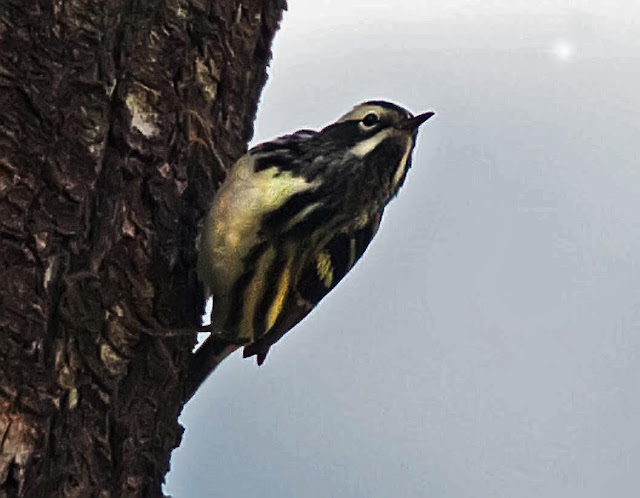However there were large numbers of shorebirds and seabirds. I was thrilled to see Red Knots, those fabled long distance travelers who on their journey from the southern tip of South America to the arctic tundra descend in huge numbers on the shores of the Delaware bay, their only stopover, where they fatten up on horseshoe crab eggs to replenish their depleted energy stores. In the last decades, though, the massive harvest of horseshoe crabs for bait has threatened the survival of the birds. A moratorium is now in place.
In the hundreds of photos I took of distant shorebirds (distant because the beaches were closed for nesting)http://www.birdcapemay.org/spring.shtml I found only three Red Knots, although I briefly saw a larger flock which landed but took off again right away. They are one of the largest sandpipers. They get their name from the red chest in breeding plumage.

 Several years ago I watched a program on PBS on horseshoe crab being harvested for their blood. It showed crabs in a large pharmaceutical lab being lined up at blood letting machinery like so many widgets. Fortunately many of the crabs survive the process and are released back into the sea.
Several years ago I watched a program on PBS on horseshoe crab being harvested for their blood. It showed crabs in a large pharmaceutical lab being lined up at blood letting machinery like so many widgets. Fortunately many of the crabs survive the process and are released back into the sea. Wikipedia.org: "Unlike mammals, horseshoe crabs do not have hemoglobin in their blood, but instead use hemocyanin to carry oxygen. Because of the copper present in hemocyanin, their blood is blue. Their blood contains amebocytes, which play a role similar to white blood cells for vertebrates in defending the organism against pathogens. Amebocytes from the blood of L. polyphemus are used to make Limulus amebocyte lysate, which is used for the detection of bacterial endotoxins.
Harvesting horseshoe crab blood involves collecting and bleeding the animals, and then releasing them back into the sea. Most of the animals survive the process; mortality is correlated with both the amount of blood extracted from an individual animal, and the stress experienced during handling and transportation. Estimates of mortality rates following blood harvesting vary from 3% to 15%."
Black Skimmers, so flamboyant in their appearance are another species that I wanted to catch on camera. Flamboyant in their appearance and habits. As their name implies with their peculiarly shaped beaks, hinged larger lower beak, they skim the surface of the water scooping up and snapping down on whatever prey comes their way. Here is a colorful description taken from BNA: The buoyant flight of this bird, coupled with its dog-like barks, prompted R. C. Murphy (1936) to describe Black Skimmers as “unworldly…aerial beagles hot on the scent of aerial rabbits.” I missed hearing that bark :-)
Black Skimmers, so flamboyant in their appearance are another species that I wanted to catch on camera. Flamboyant in their appearance and habits. As their name implies with their peculiarly shaped beaks, hinged larger lower beak, they skim the surface of the water scooping up and snapping down on whatever prey comes their way. Here is a colorful description taken from BNA: The buoyant flight of this bird, coupled with its dog-like barks, prompted R. C. Murphy (1936) to describe Black Skimmers as “unworldly…aerial beagles hot on the scent of aerial rabbits.” I missed hearing that bark :-)
The American Oystercatcher was another bird on my list to see. I am familiar with the Eurasian species. They are similar but not the same.
Their beak is laterally flattened to squeeze into a tiny opening of a bivalve and cut the adductor muscle. If the clam is closed they use their beak to hammer a hole into the shell.
Courting pair in a piping display walking along the beach, being briefly swallowed by a wave and reemerging unruffled.
Piping display
On nest
The birds are monogamous and stay together as long as they live. Unlike sandpipers, whose feeding habits are hard-wired and who can make it on their own, the fledglings stay with their parents for a couple of months to learn to open clams and other bivalves. Below, a chick running away to hide.
More from Cape May next week. Happy Birding!






























